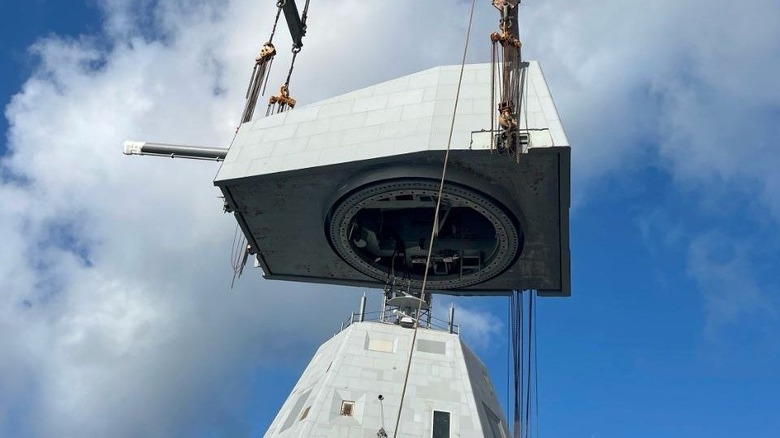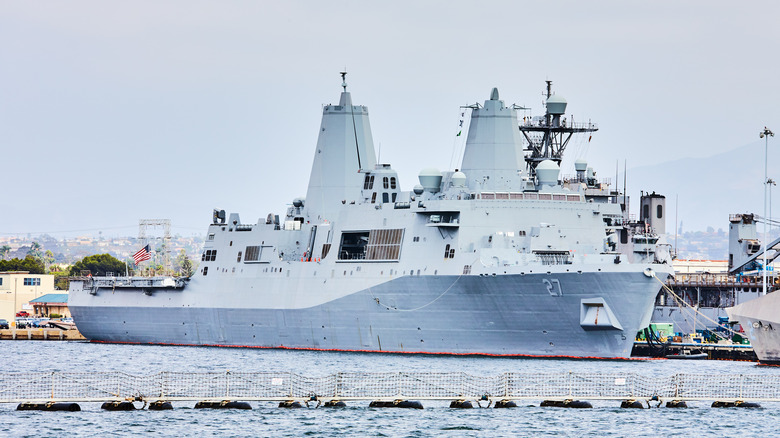What Makes The Navy's USS Zumwalt Destroyer Vessel So Special
The U.S. Navy designed the Zumwalt-class destroyer to undertake a number of responsibilities. This funny looking ship can conduct long-range precision strikes, attack and defend against nearby aircraft, conduct anti-submarine warfare (ASW), and go head-to head with other naval vessels. It also has one of the most distinct appearances in the entire arsenal of the U.S. Navy. It looks like something out of a "James Bond" movie or a sci-fi novel. This isn't the same destroyer millennials are used to seeing in the "Battleship" board game.
Not only is it a ship with a unique design, it's the largest destroyer ever built for the United States. The USS Zumwalt (DDG 1000) — named after Admiral Elmo Russell "Bud" Zumwalt Jr. — was commissioned on October 15, 2016, and completed its final delivery in April 2020. Now, after eight years of service, the Navy is outfitting the Zumwalt, along with the other two Zumwalt-class destroyers — Michael Monsoor (DDG 1001), and the Lyndon B. Johnson (DDG 1002) — with new weaponry. It's trading in its Advanced Gun System (AGS), its primary armament, for supersonic missiles, leaning into its classification as a guided missile destroyer.
Goodbye AGS
When the USS Zumwalt entered service, it was armed with two 155mm AGS that could fire six precision-guided Long Range Land Attack Projectile (LRLAP) rounds every minute, providing ground support for Marines and other land troops. That might seem like a slow rate of fire for a cannon, but when the size of the round is taken into consideration, it's actually twice as fast as its land-based 155mm Howitzer cousin. These cannons were specifically designed for the Zumwalt. They could hit targets as far as 60 miles away, which was perfect for a vessel sitting off the coastline of enemy territory.
Unfortunately, the cost of the ammunition is forcing the Navy to reconsider. $35,000 a pop is expensive for most everyday people, but it was a deal for the U.S. military. However, when it cut its order of destroyers from 32 down to three, the price per round of the 155mm shell ballooned to $800,000. Now, the Navy is outfitting the Zumwalt-class destroyer with the Common Hypersonic Glide Body (C-HGB) missiles to replace the AGS.
Hello C-HGB missiles
These large C-HGB missiles were originally planned to find a home in the Block V Virginia-class attack submarines, but without its 155mm AGS, the destroyers had prime real estate available. So, they were bumped ahead of the subs. These missiles are perfect for the largest destroyer in the U.S. fleet, as they're too large for the Navy's Mark 41 vertical launch missile silos. The C-HGB missiles launch vertically into the atmosphere, where they remain until they're closer to their target, at which point they glide downward to strike.
Hypersonic weapons like this are a challenge to intercept since they fly fast and out of range of most defensive systems. They don't fly as fast as ballistic missiles, which can exceed Mach 20, but they do fly at a minimum of 3,836 mph — over Mach 5. While the Navy hasn't stated the C-HGB's maximum speed, it's believed that they fly 13,043 mph — or Mach 17. Possibly as fast as Mach 20. The best defense against them are surface-to-air missiles intended to take out ballistic missiles.
With a maximum range of 1,725 miles, the Zumwalt doesn't need to be remotely close to its target for a precision strike, making it difficult for enemies to identify the missile's target until its too late.
Next generation technology in the ship's design
The strange design behind this guided missile destroyer is more about function than style. While it looks like a piece of a video game that didn't fully render, the angular shape, along with the materials it's made from, minimizes the radar cross-section. It can be right up in the littorals and remain invisible to radar. Furthermore, the Zumwalt handles choppy waters better than any other vessel on the open seas thanks to its pointed bow, letting it cut straight through rough waves.
When it comes to weaponry, this ship is loaded to the brim with advanced artillery. The type of ship (destroyer) suggests that its suited for destroying objects, which is why all 610 feet of it is armed with 80 advanced Peripheral Vertical Launch (PVLS) cells. These cells are suited for Tomahawks, Evolved Sea Sparrow Missile (ESSM), Standard Missiles, and Vertical Launch Anti-Submarine Rockets (ASROC). In addition to its surplus missile launchers, it's also equipped with two 30mm Close-in Guns Systems (CIGS). The Zumwalt-class destroyer is prepared for a bevy of missions.
The Zumwalt's future
On top of its new supersonic weapons, the Chief of Naval Operations Admiral Mike Gilday wants to equip the three Zumwalt-class destroyers with laser guns, fulfilling its sci-fi motif. However, this isn't completely off base, as there have been laser weapons used in the past. In 2014, the USS Ponce — an Austin-class amphibious transport ship — successfully tested the An-SEQ-3 laser in the Persian Gulf. Since then, other Laser Weapons Systems (LaWS) have been outfitted on the USS Portland.
The Portland tested the MK 2 MOD 0 — otherwise known as the Solid State Laser, the Navy's most powerful laser weapon — in May 2020. It puts out 150 kilowatts of power, compared to the Ponce's 30 kilowatts from the An-SEQ-3 laser. It was a significant leap forward in laser technology. They're typically used to blind a drone's optical system but, like the British Navy, the USS Portland also uses its laser to torch drones and other small crafts.
Admiral Gilday, however, believes the Zumwalt is suited for a significantly more powerful laser because it alone generates 78 megawatts of power. That kind of power could support a powerful enough laser to take out manned aircraft, along with ballistic missiles. The Lexington Institute, when discussing military applications of lasers, says, "It would take power levels between several hundred kilowatts and a megawatt to have an effective capability to counter manned aircraft and ballistic or cruise missiles." The Zumwalt-class ships have the power for it, now there just needs to be a laser with that kind of output.




